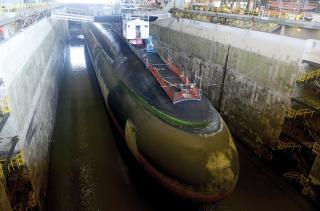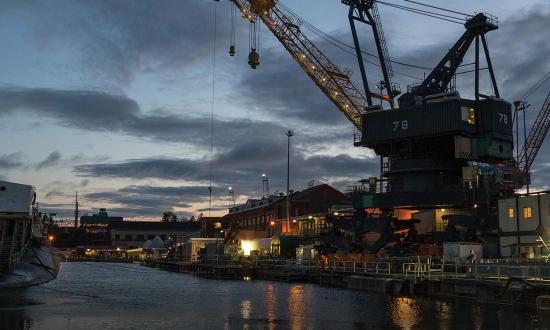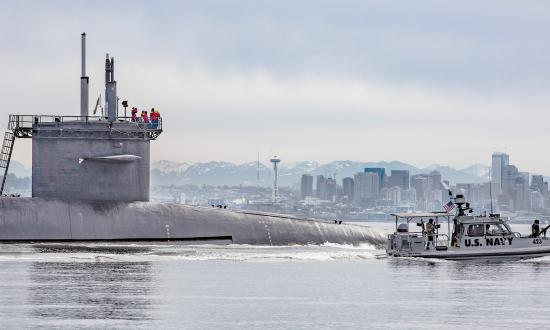The demands placed on a submarine crew during a major shipyard maintenance availability present a host of challenges not faced when pierside. Infrequent maintenance, shipyard test procedures, additional training, and being the lowest priority for trainers are just some of the problems encountered by crews in a shipyard. Combined, these lead to a lower combat readiness once the ship gets underway. This is an unacceptable position for sailors when they return to sea. They must be ready the day they get underway to track adversary submarines and, if at war, they must be ready to inflict violence on the enemy. The current shipyard environment does not allow this.
One of the most disruptive burdens is the requirement for the crew to first- and second-check all shipyard tags and have an officer verify the boundaries are adequate for shipyard work. Per the Tagout User Manual, shipyard workers propose tagout boundaries and then deliver them to the division that owns the system. Two sailors independently check the tag. If it consists of multiple systems, it will go to another division for first- and second-crosscheck. Once these checks are complete, the tagout goes to an officer who validates the boundaries as the assistant authorizing officer (AAO). The duty officer acting as the authorizing officer (AO) then validates the effect the tag has on the ship and issues it to be hung.
The Tagout Bottleneck
During a typical week, qualified AAOs spend six to eight hours authorizing tagouts for shipyard work. This time is spent looking at the drawings, technical manuals, shipyard mapping boards, and shipyard technical work documents to validate the adequacy of the tagout coverage. Under a single work authorization form (WAF) and single tagout, multiple jobs can be included. This requires looking at the list of authorized work to ensure the tags are sufficient for the scope of work. It also requires looking at the shipyard mapping boards as well as the standard ship’s drawings because of the temporary power and systems that are connected. This is a large demand on the wardroom’s time.
In the shipyard, the size of the ship’s wardroom varies from 9 to 16 officers, depending on the number of officers temporarily riding operational submarines for qualifications and experience. When my submarine, the USS California (SSN-781), was down to nine officers, we had the commanding officer, the weapons department head who was acting executive officer, the engineer, and six junior officers. The executive officer, navigator, and four junior officers were riding other submarines, while one junior officer was at the Prospective Nuclear Engineering Officer course. This meant six officers had to serve as AAOs for ten divisions’ tagouts, typically with two of them on duty at a time. Thus, only four junior officers were available to act as AAOs on a given day. During this time, it was typical to spend eight to ten hours per officer per week authorizing tags. Inevitably, shipyard work was delayed because of the sheer volume of work placed on the wardroom.
I had to delay work several times because I was authorizing tags at 1900, as I was finishing a long duty day, and I recognized that I could not sign my name to those tags and say that they were adequate because of fatigue. There is not enough time in the day to stand duty, go to training, run a division (or multiple divisions), and check every line item as fast as the shipyard wants it done. On average, there are four to six tagouts waiting on authorization at the daily project meeting. This is not a big problem for the enlisted personnel in the divisions. While it is still a lot of work, there are at least three sailors to one officer per tagout. The limiting factor in completing tagouts is almost always the availability of an AAO.
Improve the Process
There are two options to help alleviate the burden on the wardroom and make the process more efficient. First, delegate the AAO responsibility to the shipyard repair activity (RA) for RA work on systems under RA operational control. This would have the RA propose the tagout, the applicable ship’s division personnel first- and second-check the tag, and then the RA authorize it. This would put the final responsibility for the accuracy and adequacy of the tagout with the organization doing the work while having temporary control of the system.
This change still provides the ship with a divisional check of the tagout by two qualified petty officers, who are the technical experts, to ensure the shipyard is tagging it out properly. And the duty officer (AO) would then perform the same function he or she does now—validate the effect the tagout has on the ship and ensure initial conditions are set. During our last availability, the AAO found safety problems with 3 of 5,000 tagouts—less than 0.1 percent. There were also two tagouts that had been through the entire process and were found to still have voltage during initial voltage verifications because personnel did not tagout a secondary power source. In about 0.5 percent of all tagouts, AAOs will find a nomenclature issue, or will have the boundaries changed because they are too limiting on the system. While these are discrepancies, they are administrative in nature and not safety related.
Shipyard workers are better equipped to perform as AAOs for their work on systems under their control. During the shipyard availability, the ship’s crew is not allowed to operate these systems or perform maintenance on them. Shipyard personnel are the ones who prepare the WAFs, communicate with the shops, and fully understand what is going on. Finally, the shipyard has the manpower to process work controls and not delay work. Each project has multiple qualified RA lead test and shift test engineers who supervise the tagouts. They almost always have support from multiple personnel until 2300 (excluding holidays) each work day, which gives them the flexibility the wardroom does not have.
An alternative to having shipyard workers act as AAOs would be to expand Appendix C of the Tagout User Manual to include systems under shipyard operational control. Currently, Appendix C’s scope is limited to shipyard support systems and test equipment under shipyard operational control, decommissioned ships, and new-construction ships prior to being manned by Navy crews. Appendix C would give the shipyard full authority for implementing its tagouts. This would remove the first and second check and save the divisions more than 6,000 man hours during an 18-month availability. Appendix C exists to avoid overly burdening crews with tagouts that are not their responsibility.
To mitigate the concern of removing the division’s involvement with maintenance occurring on their system, each division would assign one knowledgeable petty officer per system to be a system expert. Their job would be to track all shipyard work occurring and the required retests, key events, and major milestones until the division can take back the system. This program would push ownership down to the lowest level and create close coordination between the division and shipyard. It would be much more effective than having division personnel just see tagouts for various work. The system expert program is a proactive model that would negate the need for crews to be involved in every tagout the shipyard does.
With either of these proposals, the time savings would pay major dividends in the readiness of the ship. Rather than spending an entire afternoon looking at the fourth iteration of a boundary shift to support shipyard testing, sailors could be in a trainer or on the boat doing onboard team training to get ready to return to sea. Officers could spend time reviewing the Contact Management Manual or Approach and Attack Manual rather than authorizing tagouts until 1900 the night before a trainer. Saving this time is particularly urgent given that trainer time is in high demand. Beyond more training opportunities, this would create opportunities for sailors to observe more senior sailors perform infrequent maintenance, or go on liberty, improving quality of life and satisfaction with work.
Ultimately, this decision comes down to risk versus reward. Is the risk of removing AAO responsibility from ship’s officers or even removing crew involvement in tagouts completely worth the saved time and increased training of the crew? In a peacetime Navy in which junior officer retention is high, it would most likely not be worth the tradeoff. But in a time of increasing tension and potential conflict, a new calculus must emerge. Revising the Tagout User Manual to shift the AAO burden to the shipyard or broadening the scope of Appendix C would better prepare submarines in shipyard maintenance to go to war on day one without negatively impacting junior officer retention or significantly affecting the safety of shipyard workers. The Navy no longer has the luxury of relying on an extended work-up period to prepare submarines to deploy and therefore needs to increase training in warfighting skills while in the shipyard. This can only be done if crews are relieved of the burden of performing redundant checks of shipyard work.







